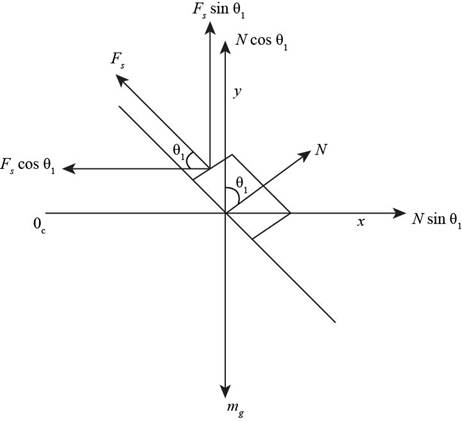
Concept explainers
(a) A luggage carousel at an airport has the form of a section of a large cone, steadily rotating about its vertical axis. Its metallic surface slopes downward toward the outside, making an angle of 20.0° with the horizontal. A piece of luggage having mass 30.0 kg is placed on the carousel at a position 7.46 m measured horizontally from the axis of rotation. The travel bag goes around once in 38.0 s. Calculate the force of staticfriction exerted by the carousel on the bag. (b) The drive motor is shifted to turn the carousel at a higher constant rate of rotation, and the piece of luggage is bumped to another position, 7.94 m from the axis of rotation. Now going around once in every 34.0 s, the bag is on the verge of slipping down the sloped surface. Calculate the coefficient of static friction between the bag and the carousel.
(a)
The force of static friction exerted by the carousel on the bag.
Answer to Problem 6.47AP
The force of static friction exerted by the carousel on the bag is
Explanation of Solution
Given info: The metallic surface of a luggage carousel slopes downward toward outside at an angle
Formula to calculate the centripetal force is,
The horizontal force acting on the bag in horizontal direction is,
Substitute
Here,
Substitute
Draw the free body diagram for the luggage.

From the Figure (1), the component of force in
From the Figure (1), the component of force in
Substitute
Simplify the above equation.
Substitute
Conclusion:
Therefore, the force of static friction exerted by the carousel on the bag is
(b)
The coefficient of friction between the bag and the carousel.
Answer to Problem 6.47AP
The coefficient of friction between the bag and the carousel is
Explanation of Solution
Given info: The metallic surface of a luggage carousel slopes downward toward outside at an angle
Substitute
Calculate the centripetal force for the bag.
Substitute
Calculate the normal force for the bag when it is on the carousel.
Substitute
Formula to calculate the coefficient of friction between the bag and the carousel is,
Substitute
Conclusion:
Therefore, the coefficient of friction between the bag and the carousel is
Want to see more full solutions like this?
Chapter 6 Solutions
Physics for Scientists and Engineers, Technology Update (No access codes included)
- Three moles of an ideal gas undergo a reversible isothermal compression at 20.0° C. During this compression, 1900 J of work is done on the gas. For related problem-solving tips and strategies, you may want to view a Video Tutor Solution of Entropy change in a free expansion. Part A What is the change of entropy of the gas? ΤΕ ΑΣΦ AS = Submit Request Answer J/Karrow_forward5.97 Block A, with weight 3w, slides down an inclined plane S of slope angle 36.9° at a constant speed while plank B, with weight w, rests on top of A. The plank is attached by a cord to the wall (Fig. P5.97). (a) Draw a diagram of all the forces acting on block A. (b) If the coefficient of kinetic friction is the same between A and B and between S and A, determine its value. Figure P5.97 B A S 36.9°arrow_forwardPlease take your time and solve each part correctly please. Thank you!!arrow_forward
- help me answer this with explanations! thanks so mucharrow_forwardNo chatgpt pls will upvote Alreadyarrow_forwardWhat fuel economy should be expected from a gasoline powered car that encounters a total of 443N of resistive forces while driving down the road? (Those forces are from air drag, rolling resistance and bearing losses.) Assume a 30% thermodynamic efficiency.arrow_forward
- No chatgpt pls will upvotearrow_forward12. What is the angle between two unit vectors if their dot product is 0.5?arrow_forwardIf the car in the previous problem increases its power output by 10% (by pressing the gas pedal farther down), at what rate will the car accelerate? Hint: Consider the net force. In the previous problem the power was 31.8kWarrow_forward
- What power is required (at the wheels) for a 1400 kg automobile to climb a 4% grade at a constant speed 30 m/s while it is opposed by drag and rolling resistance forces totaling 500 N?arrow_forwardNo chatgpt pls will upvotearrow_forwardAs a box is lifted against gravity and placed on a shelf, how does the work done by the lifter compare with the work done by gravity? What is the net work done on the box? What does this imply about its change in kinetic energy? Use definitions and mathematics from this chapter to answer these questions.arrow_forward
 University Physics Volume 1PhysicsISBN:9781938168277Author:William Moebs, Samuel J. Ling, Jeff SannyPublisher:OpenStax - Rice University
University Physics Volume 1PhysicsISBN:9781938168277Author:William Moebs, Samuel J. Ling, Jeff SannyPublisher:OpenStax - Rice University Principles of Physics: A Calculus-Based TextPhysicsISBN:9781133104261Author:Raymond A. Serway, John W. JewettPublisher:Cengage Learning
Principles of Physics: A Calculus-Based TextPhysicsISBN:9781133104261Author:Raymond A. Serway, John W. JewettPublisher:Cengage Learning Physics for Scientists and Engineers: Foundations...PhysicsISBN:9781133939146Author:Katz, Debora M.Publisher:Cengage Learning
Physics for Scientists and Engineers: Foundations...PhysicsISBN:9781133939146Author:Katz, Debora M.Publisher:Cengage Learning Glencoe Physics: Principles and Problems, Student...PhysicsISBN:9780078807213Author:Paul W. ZitzewitzPublisher:Glencoe/McGraw-Hill
Glencoe Physics: Principles and Problems, Student...PhysicsISBN:9780078807213Author:Paul W. ZitzewitzPublisher:Glencoe/McGraw-Hill Classical Dynamics of Particles and SystemsPhysicsISBN:9780534408961Author:Stephen T. Thornton, Jerry B. MarionPublisher:Cengage Learning
Classical Dynamics of Particles and SystemsPhysicsISBN:9780534408961Author:Stephen T. Thornton, Jerry B. MarionPublisher:Cengage Learning Physics for Scientists and Engineers, Technology ...PhysicsISBN:9781305116399Author:Raymond A. Serway, John W. JewettPublisher:Cengage Learning
Physics for Scientists and Engineers, Technology ...PhysicsISBN:9781305116399Author:Raymond A. Serway, John W. JewettPublisher:Cengage Learning





